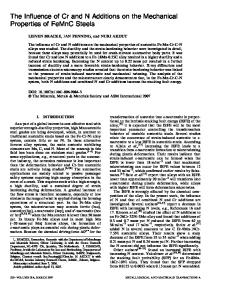Optimization of mechanical properties of high-carbon pearlitic steels with Si and V additions
- PDF / 671,511 Bytes
- 12 Pages / 612 x 792 pts (letter) Page_size
- 64 Downloads / 287 Views
NTRODUCTION
THE primary requirements for high-strength wire applications are tensile strength, ductility, and formability. Colddrawn plain-carbon pearlitic steels have commonly been employed for this purpose. The properties of such drawn wires are a function of the strength and microstructure of the feedstock, the amount of reduction during drawing, and the geometry of the dies. It is known that there are limitations on the strength that can be achieved in as-patented plaincarbon steels through changes of the heat-treatment conditions, amount of cold deformation, die geometry, and temperature of the drawn wire (dynamic aging and static aging). Although very-fine-diameter pearlite wire has achieved very high strength,[1,2] it is difficult to draw plain-carbon steels into wire of a strength higher than 2000 MPa with a large finished diameter (⬎2 mm). A relatively larger rod feedstock diameter is necessary, and this makes it difficult to achieve the rapid transformation conditions needed to produce the finest pearlite spacings and, hence, to obtain the highest rod strengths. Also, drawing a larger cross section rod introduces nonuniform deformation and may even cause premature failure when processing plain-carbon steels. Similar problems are also found in drawing large cross section nonferrous composites.[3] The other method to increase the strength of the wire, if a large final cross section is required, is to increase the tensile strength of the rod prior to cold drawing. This permits a desired final wire tensile strength to be achieved with a smaller overall drawing strain. The most efficient ways to develop such a high-strength rod from the customary pearlite microstructure are to add alloy elements or increase the carbon content. If the carbon content is increased to higher than 0.8 wt pct, K. HAN is with the National High Magnetic Field Laboratory, Florida State University, Tallahassee, FL 32308. D.V. EDMONDS, Professor, is with the School of Engineering, University of Leeds, Leeds, LS2 9JT, United Kingdom. G.D.W. SMITH, Professor, is with the Department of Materials, Oxford University, Oxford, OX1 3PH, United Kingdom. Manuscript submitted June 5, 2000. METALLURGICAL AND MATERIALS TRANSACTIONS A
continuous grain-boundary cementite can form and cause embrittlement.[4,5] Nevertheless, we have found that it is possible to use pearlitic steels with carbon contents greater than 0.8 wt pct without the formation of a continuous cementite network by the addition of silicon and vanadium together.[6,7] The addition of vanadium results in the fragmentation of the grain-boundary cementite network, and the presence of silicon acts as a kinetic inhibitor to cementite growth during transformation. The addition of vanadium is also beneficial to the stability of the cold-drawn pearlite. The interstitial atoms, especially nitrogen, dissolved in ferrite may cause a significant reduction of the ductility of the steels because of strain aging.[8,9] By the addition of vanadium, the nitrogen dissolved in ferrite[10] can be removed by
Data Loading...











